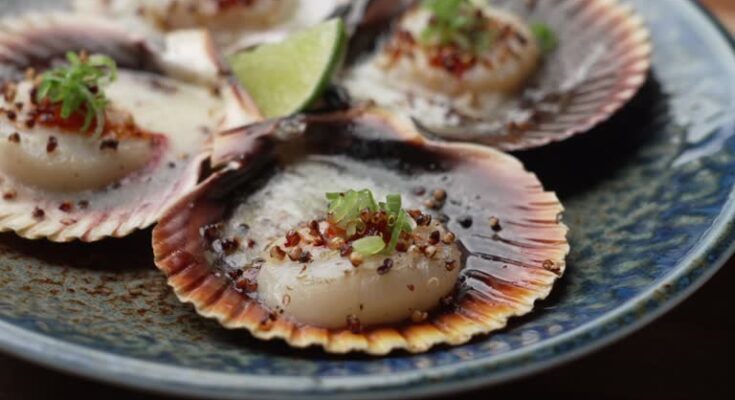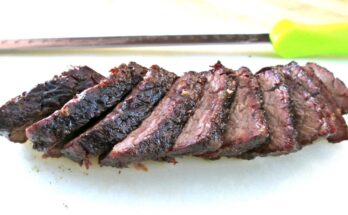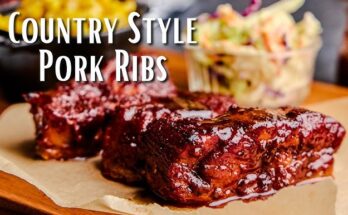Seared Scallops Recipe: Seared scallops are one of those culinary gems that strike the perfect balance between simplicity and elegance. They’re the kind of dish that instantly elevates your dinner table, making it feel like a five-star experience without the need for a reservation or a tuxedoed server. With their mild, sweet flavor and tender, buttery texture, scallops appeal even to people who might not normally gravitate toward seafood. And let’s not forget the impressive sear—that golden crust that gives way to a juicy center. That’s where the magic happens.
What makes scallops so special is their versatility. You can serve them as a main dish, an appetizer, or even as part of a surf-and-turf combo. Their subtle flavor profile means they can be paired with bold sauces or kept simple with lemon and butter. No matter how you dress them up, scallops always deliver that “wow” factor.
Another huge plus? Scallops cook incredibly fast. We’re talking less than 10 minutes from pan to plate. That makes them perfect for weeknight dinners or last-minute gourmet meals when you’re trying to impress someone. Add to that their high protein content and low fat count, and it’s easy to see why scallops have earned a permanent place in the heart of seafood lovers everywhere.
Perfect for Beginners and Pros Alike
Think you need to be a Michelin-starred chef to cook scallops perfectly? Think again. One of the best things about seared scallops is how beginner-friendly they are. Sure, the idea of cooking them might sound intimidating, especially since overcooked scallops can turn rubbery real quick. But with the right technique and a hot pan, anyone can achieve that golden-brown crust and tender interior.
This guide breaks everything down step by step, from choosing your scallops to searing them to perfection. Whether you’re just starting out in the kitchen or you’ve got years of culinary experience under your belt, there’s always something satisfying about nailing the sear on a batch of scallops.
Ingredients You’ll Need
Freshness Matters – Choosing the Best Scallops
When it comes to scallops, freshness isn’t just important—it’s everything. You want to start with the highest-quality scallops you can find. There are two main types you’ll see at the market: wet and dry scallops. Always go for dry scallops if you can. Wet scallops are treated with a phosphate solution that helps them retain water, which makes them harder to sear properly. Dry scallops, on the other hand, are untreated and sear beautifully, giving you that golden crust every time.
Look for scallops that are ivory or creamy white, with a slightly sweet, oceanic smell. They should feel firm to the touch—not slimy or mushy. If you’re buying frozen scallops, make sure they’re vacuum-sealed and free of freezer burn. Thaw them overnight in the fridge for the best results.
Basic Ingredients for Perfect Flavor
Here’s what you’ll need to create the ultimate seared scallops:
- 1 lb dry sea scallops (around 10–12 scallops)
- Salt and freshly cracked black pepper
- 2 tablespoons high smoke-point oil (like grapeseed, avocado, or canola oil)
- 2 tablespoons unsalted butter
- 2 cloves garlic, smashed
- 1 sprig fresh thyme or rosemary (optional but highly recommended)
- Fresh lemon wedges (for serving)
These ingredients might seem basic, but don’t be fooled. Scallops are delicate, and their natural flavor shines best with minimal seasoning. The goal is to enhance, not overwhelm.
Kitchen Tools for the Perfect Sear
Must-Have Equipment
The right tools can make or break your scallop game. Here’s what you absolutely need:
- Heavy-bottomed skillet or stainless steel pan – This is key for achieving a hard sear. Nonstick pans just don’t get hot enough.
- Paper towels – You’ll use these to pat the scallops dry, which is crucial for browning.
- Tongs or a fish spatula – These help you flip the scallops gently without tearing them apart.
- Instant-read thermometer (optional but useful) – Perfectly cooked scallops hit an internal temp of about 115°F–120°F.
Don’t skimp on the pan. Cast iron or stainless steel works best because it holds heat evenly and gets screaming hot. That’s what gives you that beautiful crust.
Optional Add-ons for Enhanced Results
Want to take your scallop game to the next level? Consider these extras:
- Basting spoon – This is great for spooning butter over the scallops during the final moments of cooking.
- Aromatics like shallots or sage – Add them to the butter for extra flavor.
- Deglazing liquid – A splash of white wine, vermouth, or lemon juice can turn the pan drippings into a quick sauce.
These little upgrades aren’t necessary, but they do add depth and complexity to your dish.
Step-by-Step Instructions to Sear Scallops Like a Pro
Step 1: Prepping the Scallops
First things first—take the scallops out of the fridge and let them sit at room temperature for about 10–15 minutes. This helps them cook more evenly. If your scallops still have the small side muscle attached (it looks like a little flap), gently peel it off. It’s perfectly edible but tends to be a bit chewy.
Now rinse the scallops under cold water to remove any sand or grit, then dry them thoroughly with paper towels. And we mean thoroughly. Moisture is the enemy of a good sear. Press down firmly with the paper towels to make sure they’re bone dry.
Step 2: Pat Dry and Season
Now that your scallops are prepped, it’s time to season them. This step might seem basic, but it’s super important. Remember, scallops have a delicate, natural sweetness that doesn’t need much help. A light sprinkle of kosher salt and freshly cracked black pepper on both sides is all you need to bring out that flavor.
Some cooks like to add a dash of paprika or garlic powder, but honestly, the simpler, the better. The real flavor comes from the sear and the butter bath at the end. Don’t season them until you’re just about to cook. Salt draws out moisture, and we’ve already talked about how crucial it is to keep these guys dry.
Once seasoned, let them sit uncovered on a paper towel-lined plate while you heat up the pan. This allows any remaining surface moisture to evaporate.
Step 3: Get the Pan Screaming Hot
This is where the magic begins. Heat your skillet over medium-high heat until it’s really hot—almost smoking. You want that pan to be so hot that the scallops sizzle the moment they hit it. Add 2 tablespoons of a high smoke-point oil like grapeseed or avocado oil. Swirl it around to coat the pan evenly.
Give it another 30 seconds, and you’re ready to go. If you’re unsure whether the oil is hot enough, drop a tiny bit of water into the pan—it should sizzle and evaporate instantly. You can also gently hover your hand above the pan (don’t touch it!). If it feels blazing hot, you’re good to go.
This is not the time for olive oil or butter—those will burn before your scallops even get a chance to sear. Stick to neutral oils with a high smoke point for this stage.
Step 4: Sear to Golden Perfection
Carefully place the scallops into the pan, one at a time, using tongs or your fingers. Lay them down in a clockwise pattern so you’ll remember the order you added them—this way you can flip them in the same sequence for even cooking. Don’t overcrowd the pan; give each scallop its own little space to breathe.
Now, do not touch them. No poking, no flipping, no moving around. Let them cook undisturbed for 1.5 to 2 minutes. You’re aiming for a deep, golden-brown crust. When it’s time to flip, they should release easily from the pan. If they’re sticking, they’re not ready yet.
Flip and sear the other side for about 1 to 1.5 minutes. The goal is that golden crust on both sides with an interior that’s still soft and slightly translucent in the center. Overcooked scallops turn rubbery fast, so keep your eyes (and nose) on the prize.
Step 5: Finish with Butter and Aromatics
Here’s where things get downright luxurious. Once you flip the scallops and they’re about 30 seconds from done, toss in 2 tablespoons of unsalted butter, a smashed garlic clove or two, and a sprig of thyme or rosemary. As the butter melts and foams, tilt the pan slightly and use a spoon to baste the scallops with the melted butter. This adds richness and infuses the scallops with fragrant, nutty goodness.
Keep basting for another 30 seconds or so, then remove the scallops from the pan immediately. Place them on a plate lined with a paper towel to soak up any extra butter and oil. Let them rest for a minute before serving—they’ll finish cooking with residual heat and be absolutely perfect.
At this point, you can drizzle a little lemon juice over them for a pop of acidity or serve them just as they are. Either way, they’re going to blow minds.
Serving Suggestions
Pairings That Complement Scallops
Seared scallops are super versatile, so pairing them with the right sides can elevate your meal from good to unforgettable. Here are some winning combos:
- Creamy risotto – Classic pairing. The creaminess of the rice balances the crispness of the scallops.
- Garlic mashed potatoes – Rich, smooth, and a perfect canvas for those buttery scallops.
- Herbed couscous or quinoa – A lighter, grainy option that adds texture.
- Sautéed spinach or asparagus – Earthy greens make a great contrast to the sweetness of scallops.
- Lemon butter pasta – Simple, citrusy, and indulgent.
For drinks, white wines like Chardonnay, Pinot Grigio, or Sauvignon Blanc pair beautifully. Want to go fancy? A crisp Champagne adds bubbles and brightness that match the scallop’s delicate flavor.
Plating Tips for That Restaurant-Style Look
If you’re cooking for guests or just want to impress yourself (no shame in that), presentation matters. Here’s how to plate your scallops like a pro:
- Use a white plate to make the golden-brown sear pop visually.
- Place your sides down first (like a swipe of purée or a bed of risotto).
- Space the scallops evenly—odd numbers usually look better on a plate (3 or 5).
- Drizzle with pan juices or a citrusy reduction for a restaurant-quality finish.
- Garnish with microgreens, a twist of lemon, or finely chopped herbs like chives.
Eating with your eyes first? That’s the motto here.
Mistakes to Avoid When Cooking Scallops
Overcooking – The Biggest Crime
Let’s be real—overcooking scallops is probably the number one reason people shy away from making them at home. And honestly, it’s easy to do. Scallops cook in just a couple of minutes, so the line between perfect and rubbery is razor-thin. The trick is knowing when to pull them off the heat.
So how do you avoid turning your tender scallops into chewy hockey pucks? Watch the color and feel. When done right, the outside should be golden brown, and the inside should still look a little translucent—kind of like a medium-rare steak. If you’re unsure, use an instant-read thermometer. Pull them at 115°F–120°F and let carryover heat do the rest.
Another helpful tip: cook in batches if necessary. Overcrowding the pan causes the temperature to drop, leading to steaming rather than searing. If you’re making a big batch, keep the cooked ones warm in a low oven (around 200°F) while you finish the rest.
Using the Wrong Oil or Pan
This one’s a silent killer. You could have the freshest scallops in the world, but if your oil or pan isn’t right, you won’t get that gorgeous crust.
First, let’s talk oil. Avoid butter or extra virgin olive oil for the initial sear—they both have low smoke points and will burn before your scallops have time to caramelize. Stick to oils like grapeseed, avocado, vegetable, or canola. Save the butter for basting at the end.
Now for the pan. Nonstick just won’t cut it. You need a heavy-bottomed skillet like stainless steel or cast iron that holds and distributes heat evenly. These types of pans allow you to get the kind of sear that makes scallops restaurant-worthy.
Also, make sure your pan is hot before adding the scallops. If the oil isn’t shimmering or slightly smoking, it’s not ready. You want that instant sizzle when the scallop hits the pan—it’s the sound of greatness happening.
Nutritional Benefits of Scallops
High Protein, Low Fat Goodness
Scallops aren’t just a treat for your taste buds—they’re good for your body too. These little shellfish are packed with lean protein, making them a fantastic choice for anyone watching their calories but still wanting something satisfying. A standard serving (about 3 ounces) gives you roughly 20 grams of high-quality protein and less than 100 calories. That’s some serious nutritional bang for your buck.
They’re also incredibly low in fat, especially saturated fat. That makes them a heart-healthy option, especially when paired with veggies and whole grains. Want to build muscle? Scallops are a clean protein source that helps with recovery and maintenance without the heaviness of red meat.
Packed With Essential Vitamins and Minerals
Beyond protein, scallops come loaded with important nutrients. They’re rich in:
- Vitamin B12 – Crucial for brain health and energy levels.
- Magnesium and potassium – Help regulate blood pressure and nerve function.
- Zinc and selenium – Support immune health and act as antioxidants.
- Omega-3 fatty acids – Promote heart and brain health.
Scallops are also a good source of iron, which helps transport oxygen in the blood and keeps you from feeling fatigued.
Even better? Scallops are naturally gluten-free, carb-free, and sugar-free. So whether you’re paleo, keto, low-carb, or just trying to eat clean, scallops check all the boxes.
FAQs about Seared Scallops Recipe
What type of scallops are best for searing?
For searing, it’s best to use large sea scallops. They have a sweeter flavor and meatier texture, which holds up well against the high heat required for searing.
How do I prepare scallops for searing?
To prepare scallops for searing, start by patting them dry with a paper towel. This removes excess moisture and helps achieve a golden, crispy exterior. Remove the small side muscle if it’s still attached.
What is the ideal temperature for searing scallops?
The ideal temperature for searing scallops is medium-high heat. This allows the scallops to develop a nicely browned crust without overcooking the interior. Ensure your pan is hot before adding the scallops.
How long should I sear scallops?
Sear scallops for about 1-2 minutes on each side. They should have a golden crust on each side and be translucent in the center. Be careful not to overcook them as they can become tough and rubbery.
What oil should I use for searing scallops?
Use a high smoke point oil such as canola, vegetable, or grapeseed oil. These oils can withstand the high temperatures needed for searing without burning.
Can I sear scallops in butter?
Yes, you can sear scallops in butter for added flavor. However, consider using clarified butter or adding a bit of oil to regular butter to increase the smoke point and prevent burning.
What are some good seasoning options for seared scallops?
Simple seasonings work best to enhance the natural flavor of scallops. Salt and pepper are essential, but you can also add a squeeze of lemon juice, minced garlic, or herbs like parsley and thyme for extra flavor.
What should I serve with seared scallops?
Seared scallops pair well with light, refreshing sides such as sautéed vegetables, creamy risotto, or a fresh salad. For a heartier meal, serve them with pasta or a grain like quinoa.
Conclusion
There you have it—seared scallops, demystified. Whether you’re a beginner in the kitchen or a seasoned cook, this step-by-step guide gives you all the tools you need to master one of the most elegant and satisfying seafood dishes around. From choosing the freshest scallops to nailing that perfect golden sear, it’s all about confidence, technique, and a few simple ingredients.
What’s truly special about this recipe is its balance. It feels gourmet but takes less than 10 minutes to cook. It’s light yet indulgent. And most importantly, it turns an ordinary night into something worth remembering. So next time you’re thinking of cooking something special—whether for date night, guests, or just a personal treat—reach for those scallops. You won’t regret it.



